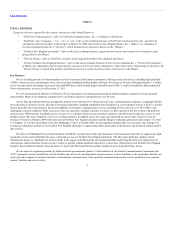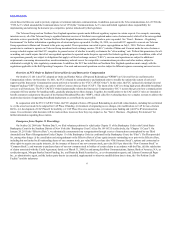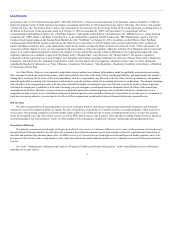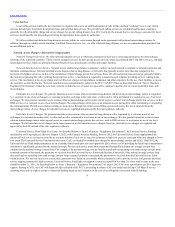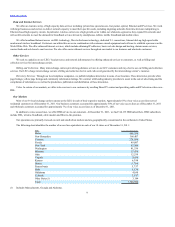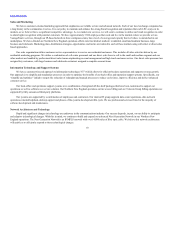FairPoint Communications 2011 Annual Report Download - page 16
Download and view the complete annual report
Please find page 16 of the 2011 FairPoint Communications annual report below. You can navigate through the pages in the report by either clicking on the pages listed below, or by using the keyword search tool below to find specific information within the annual report.
Table of Contents
Universal Service Support
Rules effective through December 31, 2011 provided different methodologies for the determination of universal service payments to rural and non-rural
carriers. In general, the rules provide high-cost support to rural carriers where the company’s actual costs exceed a nationwide benchmark level. High-cost
support for non-rural carriers, on the other hand, was determined by a nationwide cost proxy model. Under the pre-2012 FCC rules, our non-rural operations
received support under the non-rural model methodology in Maine and Vermont. The FCC’s rules for support to high-cost areas served by non-rural LECs
were remanded by the U.S. Court of Appeals for the Tenth Circuit, which had found that the FCC had not adequately justified these rules. In 2010, in
response to the Tenth Circuit remand, the FCC issued an order which justified its prior conclusion. As previously described, the FCC has replaced all pre-
2012 universal service programs with its new CAF programs.
Universal Service Fund disbursements were distributed only to carriers that are designated as “eligible telecommunications carriers” (“ETCs”) by a state
regulatory commission. All of our non-rural and rural LECs were designated as ETCs.
We also benefit indirectly from support to low-income users under the Lifeline and Linkup universal service programs. The FCC has asked the Federal-
State Joint Board for Universal Service to recommend changes to these low-income programs to address, among other things, access to broadband and
eligibility for support. On February 6, 2012, the FCC adopted and released an order reforming the Lifeline and Linkup low-income programs. Effective
April 1, 2012, the Linkup program will be eliminated for all low-income subscribers except for Native Americans. Linkup is a program which pays 50% of
the non-recurring charges, not to exceed $30.00, associated with establishment of local telecommunications service. Also effective April 1, 2012, there are major
reforms to the Lifeline program. Prior to the changes, Lifeline credits were based on four tiers of support. The first three tiers of federal support will be replaced
by a flat credit of $9.25 per month. The fourth tier, which relates to Native Americans, is unchanged. In addition, the FCC is establishing revised eligibility
criteria effective April 1, 2012. The FCC order requires the Universal Service Administration Company (“USAC”) to establish a national database by the end
of 2013 which will be used to eliminate duplicate funding. The FCC Lifeline order establishes a limited trial to evaluate Lifeline support for broadband
services. It is not known how these changes will impact us. The elimination of duplicate support could result in fewer customers choosing us for Lifeline
service, with the potential that a portion of our Lifeline customers may prefer to use other carriers for this service.
Universal Service Contributions
Federal universal service programs are currently funded through a surcharge on interstate and international end-user telecommunications revenues.
Declining long-distance revenues, the popularity of service bundles that include local and long-distance services, and the growth in size of the fund, due
primarily to increased funding to competitive ETCs, all prompted the FCC to consider alternative means for collecting this funding. As an interim step, the
FCC has ordered that providers of certain VoIP services must contribute to federal universal service funding. The FCC also increased the percentage of
revenues subject to federal universal service contribution obligations that wireless providers may use as their methodology for funding universal service. One
alternative under consideration would be to impose surcharges on telephone numbers or network connections instead of carrier revenues. Any further change in
the current assessment mechanism could result in a change in the total contribution that LECs, wireless carriers or others must make and that would be
collected from customers. We cannot predict whether the FCC or Congress will require modification to any of the universal contribution rules, or the ultimate
impact that any such modification might have on us or our customers.
Local Service Competition
The 1996 Act provides, in general, for the removal of barriers to market entry in order to promote competition in the provision of local
telecommunications and information services. As a result, competition in our local exchange service areas will continue to increase from CLECs, wireless
providers, cable companies, Internet service providers, electric companies and other providers of network services. Many of these competitors have a
significant market presence and brand recognition, which could lead to more competition and a greater challenge to our future revenue growth.
Under the 1996 Act, all LECs, including both ILECs and CLECs, are required to: (i) allow others to resell their services; (ii) ensure that customers can
keep their telephone numbers when changing carriers, referred to as local number portability; (iii) ensure that competitors’ customers can use the same number
of digits when dialing and receive nondiscriminatory access to telephone numbers, operator service, directory assistance and directory listing; (iv) ensure
competitive access to telephone poles, ducts, conduits and rights of way; and (v) compensate competitors for the cost of completing calls to competitors’
customers from the other carrier’s customers.
15


